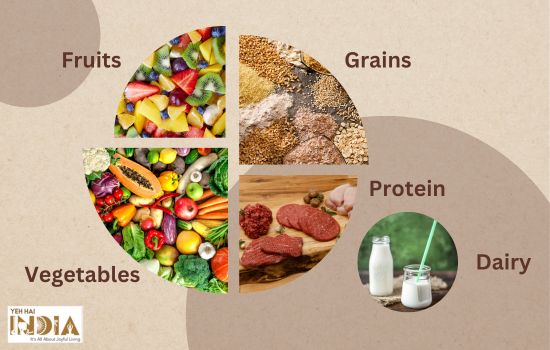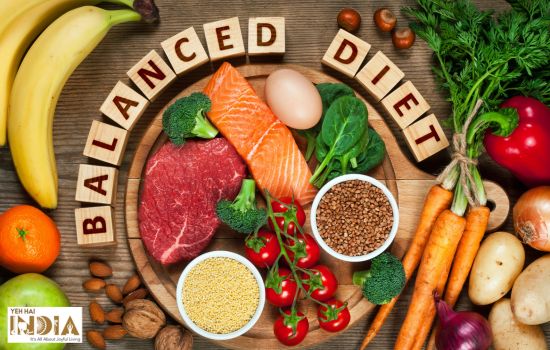The good news is that it is not difficult to achieve your health goals through a concept known as “Balanced Diet” and we will tell you how in the following article. Stay tuned!!
With so many Dos and Don’ts which come in every way when you talk of food or health, it seems so overwhelming to follow one. And also tired of everyone becoming a Health expert giving free advice which never seems to work when someone talks of losing weight.
Balanced Diet – An Introduction
A balanced diet is not one of that fad diets which comes up every other day on any kind of social platform. It is the most ideal way of eating and staying healthy.
Everything in life needs balance and so does your eating habits. And it’s not as difficult as one would think of it so, it is easy, sustainable and achievable.
This article will not only enlighten you about the importance of a balanced diet but will also help you add that to your life.
Health and Balanced Diet
A balanced diet contains different types of foods in such quantities and proportions that the need for calories, proteins, minerals, vitamins and other nutrients is adequately met. Individuals may also choose to supplement certain elements of their diet where they feel they would like a little extra helping hand in making sure they get adequate nutrition. One commonly supplemented nutrient is protein, which can be found in the form of shakes, snacks, and even things like bone broth (which you can learn more about here) and easily incorporated into a daily routine.
In addition, a balanced diet also provides dietary fibre and antioxidants which have positive health benefits.
In a balanced diet, low glycaemic index foods are preferred, these are the foods which have minimal impact on the blood sugar levels when consumed.
The emphasis is on consuming a variety of foods, including fruits, vegetables, whole grains, lean proteins, and healthy fats, while moderating the intake of added sugars, sodium, and saturated fats.
It also gives great importance to including all the food groups in the required quantity needed by the body, as each food group has its set of nutrients provided which are important for a healthy life.
Recommended Article: Beat the Heat – Shilpi’s Tips to Stay Hydrated This Summer
History As We Know It
The understanding and promotion of balanced diets have been shaped by the contributions of numerous researchers, scientists, and organizations in the field of nutrition.
In the early 20th century, pioneering nutritionists such as Casimir Funk, Elmer McCollum, and Thomas Osborne made significant advancements in identifying essential nutrients and their role in maintaining health. Their work laid the foundation for understanding the importance of a balanced intake of different nutrients.
During World War II, the British government introduced the concept of the “balanced diet” to ensure that citizens received adequate nutrition despite food rationing. This idea aimed to provide a mix of essential nutrients to promote health and prevent deficiencies.
Post-World War, organizations like the World Health Organization (WHO) and the Food and Agriculture Organization (FAO) of the United Nations played a crucial role in formulating guidelines for balanced diets.
Today, the concept of a balanced diet is widely promoted by health authorities and nutrition experts worldwide.
MyPlate Method
Let me introduce you to one of the interesting approaches to the concept of a balanced diet which is known as the “MyPlate Method.”
One approach to eating a healthy, well-balanced diet is the ‘MyPlate Method’. It involves dividing a dinner plate into 4 sections of specific groups of food and adding a serving of dairy. This version was developed by the United States Department of Agriculture (USDA).

Half of the plate should contain fruits and vegetables, with two third of vegetables and one-third of fruits. The other half of the plate should contain grains like whole grains and proteins in equal amounts. Proteins should focus on lean meats, fish and vegetarian protein options.
The following are examples of foods that can be used in each section:
Vegetables
Non-starchy fresh, frozen, or low-sodium vegetables, such as broccoli, peppers, cucumbers, tomatoes, cauliflower, and spinach.
Fruits
Fresh fruits of all colours.
Grains
Whole-wheat bread, oats, brown rice, whole-grain pasta (restriction on refined products, such as white bread and white rice)
Proteins
Lean beef, poultry, seafood, beans, soy products, eggs (restriction on bacon and other processed meats).
Dairy
Low-fat milk, yoghurt, cheese, calcium-fortified soy milk (limit to 1-2 servings a day)
Recommended Article: 10 Low-Sugar Fruits and Vegetables Good For A Low-Carb Diet
The Right Quantity For A Complete Meal
The amount of food that should be in each section varies depending on age, sex and level of physical activity. The USDA provides a MyPlate Plan on their website which takes these factors into account and provides recommendations. Using the plate method ensures that meals are balanced, containing a variety of macro and micronutrients that the body needs.
MyPlate has several limitations when talking about adding this approach to different meals. This approach can be easily achieved in the heaviest meal of the day which can be lunch. But for other lighter meals like breakfast for dinner, is it possible to use the same?
Well, yes, it is. We came up with ideas for breakfast just for you, where using MyPlate would be easier to include.
Tip #1:
Grains section: Bread
Protein section: Omelette
Vegetable section: Stir-fried vegetables
Fruits section: Any seasonal fruit
Tip #2:
Grains section: Poha
Protein section: Add Moong Dal to it
Vegetable section: Add in vegetables like carrots, capsicum, green peas to it, etc.
Fruit section: Any seasonal fruit
Tip #3:
Grain section: Bread
Protein section: Matki Usal
Vegetable section: Mixed vegetable Salad
Fruit section: Any seasonal fruit
Importance of a Balanced Diet
Eating a balanced diet is all about feeling great, having more energy, improving your health, avoiding instances of illness and boosting your mood.
The importance of nutritious food especially in children needs to be highlighted as they may end up with wasting or stunted growth also affecting their brain power by making them slower.
Some of the most common health problems that arise from the lack of a balanced diet are heart disease, cancer, stroke, and diabetes.
A balanced diet meets nutritional requirements, prevents degenerative diseases, improves longevity, prolongs productive life, improves immunity, increases endurance level, develops the optimum cognitive ability, helps in coping with stress, ability to withstand the short duration of leanness, covers energy expenditure and for tissue maintenance, repair and growth.
First, let me explain to you the benefits of a balanced diet.
Benefits of a Balanced Diet

1. Maintains body weight:
Consuming enough nutrient-dense food will leave no room for calorie-dense foods, which can add on weight and fat.
Calorie-dense foods like processed foods and fatty or sugary snack which has little or no nutrition at all, will just get stored as fat in your body.
Eating complex carbohydrates like whole grains, oats, vegetables, fruits, etc. will allow the body to stay fuller for a longer period, and also reduce unnecessary cravings.
2. Improves Immunity:
Eating a balanced diet will result in producing and maintaining cells which fight off infections and germs in the body.
Deficiencies in essential Vitamins and Minerals will impair the immune system.
A diet filled with fruits and vegetables will increase the production of infection-fighting white blood cells that keep the bacteria and infections at bay.
Not only that, one major aspect of a balanced diet is to keep the cardiovascular system healthy and reduce the risk of diseases.
Vitamin C plays an important role in improving the immune system.
It raises the level of HDL which is considered good cholesterol and it lowers the blood pressure. Also, it decreases the chance of fat getting converted to plaque in the arteries.
It limits the excess body fat that can be developed in the body causing serious health problems.
3. Increases Energy level
The food we eat has an impact on how energetic we feel throughout the day. Nutrient-dense food will digest and stay in the system over a longer period.
On the other hand, easily digestible foods like sugary food items or simple carbohydrates will digest quicker making us feel hungry in every short period. These can cause high spikes and extreme lows in the energy level, which is not the goal to feel energetic.
Eating a balanced diet will restrict such unnecessary happenings in the system.
Recommended Article: Nutrition Bowls: A Guide To Make Your Own Mini-Meal
4. Improved Sleep Quality
Sleep affects our daily performance. Quality and quantity can heavily affect different aspects of our life.
Muscle recovery and improving brain function are the major benefits of having good sleep. Without it, feeling sluggish, you have poor focus and concentration, and cravings for all unnecessary food items are triggered.
Poor sleep can also increase the acidity level making it difficult to feel good. Having a light dinner works like magic for a good night’s sleep.
Hence, a balanced diet improves the quality of sleep too.
5. Good Cognitive Function
It would be wrong to say a Balanced diet is helpful just to keep you physically healthy because it goes beyond that and works on your mental health too.
Omega 3 works best for the brain and including Omega 3-rich food items like salmon, walnut and avocado can greatly help you improve memory power, learning and development.
Next, let’s talk about what most people chase for and which is also the root cause of Non-Communicable Diseases. Yes, weight loss!!
How can balanced diet help with weight loss?

Calorie Control
A balanced diet focuses on consuming appropriate portions of different food groups while maintaining an overall calorie deficit.
This means consuming fewer calories than you expend, creating an energy imbalance that can lead to weight loss over time.
Nutrient Density
A balanced diet emphasizes nutrient-dense foods, such as fruits, vegetables, whole grains, lean proteins, and healthy fats.
These foods are typically lower in calories and higher in essential nutrients, which can help you feel more satisfied while consuming fewer calories.
Satiety and Hunger Control
A balanced diet that includes adequate amounts of fibre, protein, and healthy fats can help promote feelings of fullness and satiety.
This can reduce the tendency to overeat or snack on unhealthy, calorie-dense foods, making it easier to adhere to a calorie-controlled eating plan.
Blood Sugar Regulation
A balanced diet that includes complex carbohydrates, fibre, and a moderate amount of healthy fats and proteins can help regulate blood sugar levels.
This can prevent spikes and crashes in blood sugar, which can lead to increased hunger and cravings for sugary or high-calorie foods.
Sustainable Approach
A balanced diet is not about strict deprivation or eliminating entire food groups. It promotes a sustainable approach to weight loss by allowing for a wide variety of foods in moderation.
This can make it easier to stick to the diet long-term, leading to more successful weight management.
A Sample Case Study
To understand better let’s get to know the weight loss story of our friend Natasha on how a balanced diet helped her with her journey:
Natasha is a 35-year-old woman who wants to lose weight and improve her overall health. She works in an office environment and leads a sedentary lifestyle. Natasha’s initial weight is 81kgs, and her height is 5 feet 6 inches. After consulting with a healthcare professional, Natasha decides to adopt a balanced diet to achieve her weight loss goals.
Calorie Assessment:
The healthcare professional determines that Natasha’s estimated daily calorie needs for weight maintenance are around 2,000 calories per day. To promote weight loss, Natasha aims to create a calorie deficit by reducing her daily intake to approximately 1,500 calories.
Food Group Recommendations:
Natasha should consume a balanced diet including a variety of foods from different food groups in appropriate portions. The recommended food groups and servings follow in quantity and diversity as per the MyPlate Method shown above.
Meal Planning and Portion Control:
Natasha creates a meal plan based on the recommended food groups, portion sizes, and calorie targets. She incorporates a balance of fruits, vegetables, whole grains, lean proteins, and healthy fats into her meals. She focuses on home-cooked meals and snacks to have more control over ingredients and portion sizes.
Regular Physical Activity:
Natasha understands that a balanced diet alone may not be sufficient for weight loss. She incorporates regular physical activity into her routine, aiming for at least 150 minutes of moderate-intensity aerobic activity per week, along with strength training exercises.
Over several months of consistent adherence to her balanced diet and regular exercise, Natasha successfully achieves her weight loss goal. She experiences improved energy levels, better overall health, and greater confidence in her body.
Thus, a balanced diet helped Natasha with her weight loss and numerous others too.
Precautions and Individual Requirements To Consider
A balanced diet is easy to follow for most of the population, but the following individuals need certain modifications:
1. Individuals with Specific Medical Conditions:
Certain medical conditions, such as diabetes, food allergies or intolerances, celiac disease, kidney disease, or heart conditions, may require dietary modifications.
2. Pregnant or Lactating Women:
Pregnant and breastfeeding women have increased nutrient requirements and may need additional nutrients like folic acid, iron, and calcium.
3. Athletes or Highly Active Individuals:
Individuals engaged in intense physical activity or endurance sports may have higher energy and nutrient requirements.
Thus, we come to the end of this article. A balanced diet is the most sustainable way of eating and staying healthy. No matter in what profession you are, this, will bring you success. Investing in your health is the greatest form of investment. Stay Healthy and Live Long.
Also Read: Fortified Breakfast Cereals: Are They What They Seem to Be?









